Motion Chapter Notes | Basic Technology for JSS 3 PDF Download
| Table of contents |

|
| Introduction |

|
| Rest and Motion – Kinds of Motion |

|
| Speed and Velocity |

|
| Points To Remember |

|
| Glossary |

|
Introduction
In this chapter, we will learn about motion, which is all about how things move around us. We see motion every day, like a car driving on the road, a ball rolling on the ground, or even the Earth moving around the Sun. We will understand what it means for something to be at rest or in motion, explore different types of motion, and see how objects move in different ways. We will also learn how to tell if something is moving in a straight line, a circle, or back and forth, and how some motions repeat while others do not. This chapter will help us understand the movement of objects in a simple and fun way.
Rest and Motion – Kinds of Motion
Rest and Motion
- We use the word "rest" to talk about things that do not move, like a table or a book on a table.
- We know from our daily life that things at rest do not move on their own.
- But if we want to know if a body is really at rest, we need to check if its position changes compared to things around it over time.
- When a body's position does not change compared to its surroundings, we say the body is at rest.
- For example, a running train is in motion because its position changes compared to trees and houses outside.
- Flowing water is also in motion because its position changes over time.
- We can say something is in motion when its position changes compared to its surroundings over time.
- So, rest and motion are related terms—they are opposites of each other.
- For example, imagine you are in a bus. If you look at the trees and houses outside, they seem to move backward, so you are in motion compared to them. But if you look at the walls and seats inside the bus, your position does not change compared to them, so you are at rest inside the bus.
Types of Motion
When we look around, we see objects moving in different ways. For example, a car moves straight on a road, an electric fan spins, and a clock's pendulum swings back and forth.
We will study the different kinds of motion that objects can have:
1. Translatory Motion
- In this motion, all parts of a body move the same distance at the same time.
- For example, a car or train moving straight, a ball rolling on the ground, a girl sliding down a slope, pulling a drawer, firing a bullet, or a stone thrown from a catapult are all examples of translatory motion.
Translatory motion is of two types:
(a) Rectilinear Motion:
- When a body moves in a straight line, it is called rectilinear motion.
- For example, a ball rolling on a smooth floor moves in a straight line, so its motion is rectilinear.
- More examples of rectilinear motion:
- A train moving on a straight rail track.
- A car moving on a straight road.
- A stone falling freely from a height.
- A coin moving on a carrom board.
(b) Curvilinear Motion:
- When a body moves along a curved path, it is called curvilinear motion.
- For example, when your car moves on a curved road, its motion is curvilinear.
- More examples of curvilinear motion:
- A ball thrown upwards at an angle.
- A car or train moving on a curved road or track.
- A spinning wheel or charkha.
- A spinning top.
- A potter's wheel.
- A ceiling fan.
- The Earth moving around the Sun.
2. Circular or Rotatory Motion
- In this motion, a body moves around a fixed point or axis without changing its position, like the blades of a table fan moving in a circle. This is called circular motion or rotatory motion.
- A motion where a body moves around a fixed axis without changing its position is called circular motion.
- Examples of circular motion:
- A spinning wheel or charkha.
- A spinning top.
- A potter's wheel.
- A ceiling fan.
- The Earth revolving around the Sun.
Note: Sometimes, a body can have both translational and rotational motion at the same time. For example, when a drill cuts through metal, it spins (rotational motion) and moves forward (translational motion). So, the drill has both kinds of motion at the same time. Similarly, the wheels of a moving bicycle or scooter have both rotational motion (spinning) and translational motion (moving forward). When an object has two or more types of motion at the same time, it is called simultaneous motion.
3. Oscillatory Motion
- In this motion, some objects move back and forth or to and fro along the same path without changing their shape. This is called oscillatory motion.
- When an object moves to and fro or back and forth along the same path without changing its shape, it is called oscillatory motion.
- Examples of oscillatory motion:
- A boy on a swing moving back and forth.
- The pendulum of a clock swinging to and fro.
- The needle of a sewing machine moving up and down.
- The piston of a fruit seller's shop, the pressing cylinder of a juice machine, a spray pump, all move in oscillatory motion.
4. Vibratory Motion
- In vibratory motion, a body moves very fast, but the whole body does not move, only some parts move back and forth.
- For example, when you pluck a metal wire, it moves between points A and B, but the whole wire does not move up or down—it just vibrates.
- This kind of motion, where only a part of the body moves back and forth, is called vibratory motion.
- All musical instruments like a guitar, violin, sitar, or drums produce vibratory motion when played.
- Even when we breathe, our chest moves in and out—this is also vibratory motion because the chest does not move to a new place, it just changes shape.
- Vibratory motion is a type of oscillatory motion where the moving object changes its shape or size.
5. Periodic Motion
- In periodic motion, an object repeats its motion after a fixed amount of time.
- This motion is called periodic motion because it happens again and again after a regular interval of time.
- A motion that repeats itself after a fixed interval of time is called periodic motion.
- Examples of periodic motion:
- The piston of a motor car engine running at a constant speed moves up and down repeatedly.
- The swinging pendulum of a wall clock moves back and forth at a fixed time.
- The needle of a sewing machine running at constant speed moves up and down repeatedly.
- The heart of a normal resting person beats 72 times a minute—this is periodic motion.
- The motion of a swing moving back and forth at a fixed time.
6. Non-periodic Motion
- In non-periodic motion, an object repeats its motion, but not at a fixed interval of time.
- A motion that repeats itself but not at fixed intervals of time is called non-periodic motion.
- Examples of non-periodic motion:
- A football player running in the field—he runs fast and then slows down, so the motion is not at a fixed time.
- When brakes are applied to a moving vehicle, the motion slows down and stops—this is non-periodic motion.
- A cricket ball rolling on the ground—it slows down gradually and stops, so the motion is not at a fixed time.
7. Random Motion
- In random motion, an object moves in a way that changes its motion randomly without a specific path.
- For example, take a balloon and fill it with air, then let it go. The balloon moves in a random way because the air comes out randomly.
- Similarly, a flying mosquito, a kite in the sky, or a hockey ball on the ground all move in random motion because they do not follow a specific path and their motion changes randomly.
8. Uniform Motion
- Imagine an ant moving along a straight line from point A to E.

- In the first second, the ant covers 2 cm from A to B, in the second second it covers 2 cm from B to C, and so on.
- The ant covers 2 cm every second in a straight line, so it covers equal distances in equal intervals of time.
- This kind of motion, where a body covers equal distances in equal intervals of time along a straight line, is called uniform motion.
- For example, a train moving at a constant speed in a straight line or a flying aeroplane at a constant speed in a straight direction also shows uniform motion.
9. Non-uniform Motion
- Now imagine an ant moving along a straight line from point A to D.

- In the first second, the ant covers 3 cm from A to B, but in the next second, it covers 2 cm from B to C, and in the third second, it covers 5 cm from C to D.
- The ant covers different distances in equal intervals of time (3 cm, 2 cm, and 5 cm in 1 second each).
- This kind of motion, where a body covers unequal distances in equal intervals of time along a straight line, is called non-uniform motion.
- For example, a cyclist riding on a busy street moves fast and then slow—this is non-uniform motion because the distances covered in equal times are not the same.
Speed and Velocity
Speed
- We studied speed in the last chapter, and now we will learn more about it.
- Speed is the rate at which an object moves, or how fast or slow it changes its position.
- To find speed, we divide the distance an object travels by the time it takes to travel that distance.
- The formula for speed is: Speed = Distance covered by the object ÷ Time taken to cover the distance.
- If the distance covered is S and the time taken is t, then speed (v) = S ÷ t.
- In the Standard International (SI) system, the unit of speed is metre per second.
- We write metre per second as m/s or ms⁻¹.
- For small distances, speed can also be in cm/s (centimetres per second).
- For example, an ant or an earthworm moves at a speed in cm/s because they cover small distances.
- For large distances, speed is in km/h (kilometres per hour) or km h⁻¹.
- For example, a car or an aeroplane moves at a speed in km/h because they cover large distances.
Kinds of speed
There are two types of speed:
1. Uniform Speed:
- When an object covers equal distances in equal intervals of time, it is moving with uniform speed.
- For example, if a car covers 30 km every hour, it is moving with uniform speed. An aeroplane flying at 200 km/h or a train running at 90 km/h also moves with uniform speed.
2. Non-Uniform Speed:
- When an object covers unequal distances in equal intervals of time, it is moving with non-uniform speed.
- For example, a car covers 40 km from 6 a.m. to 7 a.m., 20 km from 7 a.m. to 8 a.m., and 30 km from 8 a.m. to 9 a.m. In 3 hours, the car covers different distances in each hour, so it is moving with non-uniform speed.
Average speed
- In real life, like when you ride a scooter to school, your speed changes depending on the road.
- Sometimes you go fast, and sometimes you go slow because of traffic or turns.
- To find out how fast you went overall, we calculate the average speed.
- Average speed is the total distance covered by an object divided by the total time taken to cover that distance.
- The formula for average speed is: Average speed = Total distance covered ÷ Total time taken to cover the distance.
- If an object travels a distance S in time t, then its speed v is: v = S ÷ t.
- When an object moves with non-uniform speed, we use average speed to find out how fast it went overall.
- For example, a car covers 40 km in the first hour, 20 km in the second hour, and 30 km in the third hour.
- The total distance covered is 40 + 20 + 30 = 90 km, and the total time taken is 3 hours.
- So, average speed = Total distance covered ÷ Total time taken = 90 km ÷ 3 h = 30 km/h.
Velocity
Let’s understand velocity with an example:
- If a machine is said to have a speed of 10 m/s, we know how fast it is moving.
- But we don’t know in which direction it is moving—will it go up, down, left, right, or into the ground?
- Speed only tells us how fast something is moving, but it does not tell us the direction.
- Velocity tells us both the speed and the direction of an object’s movement.
- For example, if a machine is moving at 10 m/s towards the east, we say its velocity is 10 m/s east.
- Velocity is the rate at which an object moves in a specific direction.
- Velocity has the same unit as speed in both CGS (cm/s) and SI (m/s) systems.
- But in velocity, we always mention the direction along with the speed.
Kinds of velocity
There are three types of velocity:
1. Uniform Velocity:
- When an object covers equal distances in equal intervals of time in a specific direction, it has uniform velocity.
- For example, a car moves straight towards the east and covers 5 m every second.
- In the diagram (Fig. 2.21), the car moves from A to B (5 m), B to C (5 m), and C to D (5 m) in 1 second each.
- The car covers equal distances (5 m) in equal intervals of time (1 s) in the same direction (east).
- So, the car has uniform velocity.
- Now, imagine the same car moving on a circular path (Fig. 2.22).
- It covers 5 m every second, but the direction keeps changing as it moves in a circle.
- Even though the speed is 5 m/s, the velocity is not 5 m/s because the direction is not the same.
- For an object to have uniform velocity, two conditions must be true:
- It must cover equal distances in equal intervals of time.
- Its direction must remain the same.
- If either of these conditions is not true, the object does not have uniform velocity.
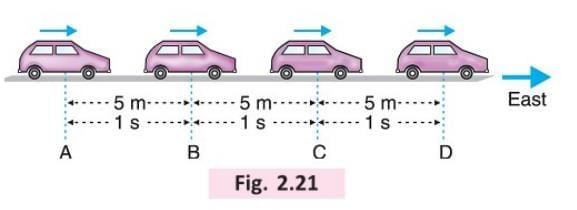
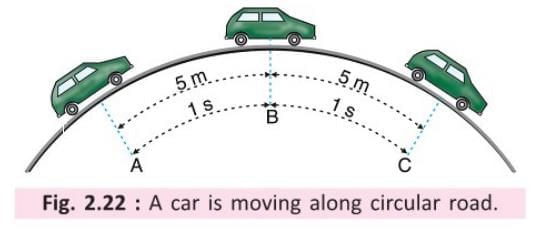
2. Variable Velocity:
- When an object covers unequal distances in equal intervals of time in a specific direction, or if the direction changes, it has variable velocity.
- For example, in Fig. 2.23, a car moves from A to B (3 m), B to C (4 m), C to D (2 m), and D to E (4 m) in 1 second each, towards the east.
- The distances are not equal (3 m, 4 m, 2 m, 4 m) even though the time intervals are equal (1 s each).
- So, the car has variable velocity because the distances are unequal.
- In another example, a car moves on a circular path (Fig. 2.22).
- It covers 5 m every second, but the direction changes as it moves in a circle.
- So, the car has variable velocity because the direction is changing.
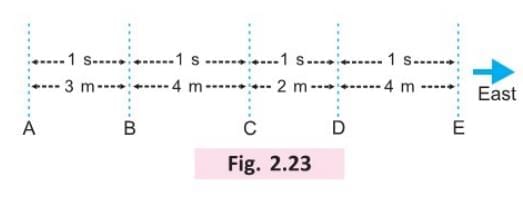
3. Average velocity:
- Average velocity is the total displacement of an object per unit time when the object has variable velocity.
- Displacement is the shortest distance between the starting point and the ending point in a specific direction.
- For example, in Fig. 2.23, a car moves from A to B (3 m), B to C (4 m), C to D (2 m), and D to E (4 m) in 1 second each, towards the east.
- The total displacement is the distance from A to E, which is 3 + 4 + 2 + 4 = 13 m east.
- The total time taken is 4 seconds (1 s + 1 s + 1 s + 1 s).
- So, average velocity = Total displacement ÷ Total time = 13 m ÷ 4 s = 3.25 m/s east.
- In another example, a body moves on a circular track of 120 m in 10 seconds (Fig. 2.23 Spotlight).
- The total distance covered is 120 m, and the time taken is 10 s.
- So, average speed = Distance ÷ Time = 120 m ÷ 10 s = 12 m/s.
- But since the body returns to the starting point after completing the circle, the displacement is 0 m.
- So, average velocity = Displacement ÷ Time = 0 m ÷ 10 s = 0 m/s.
- This shows that an object can have an average speed but an average velocity of zero if it returns to the starting point.
Mass and weight
- Mass is the amount of matter in an object.
- Mass is a constant quantity, which means it does not change if the object’s position or location changes.
- We measure mass using a physical balance or a beam balance (Fig. 2.24).
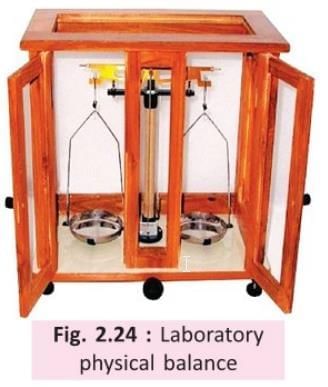
- The SI unit of mass is kilogram (kg).
- Smaller units of mass are gram (g) and milligram (mg).
- Larger units of mass are quintal and tonne.
- Multiples of mass:
- 1000 kilogram (kg) = 1 quintal.
- 1000 quintal = 1 tonne.
- Sub-multiples of mass:
- 1000 gram (g) = 1 kilogram (kg).
- 1000 milligram (mg) = 1 gram (g).
- Weight is the force with which the earth pulls an object towards its centre.
- Weight is not constant; it changes depending on the acceleration due to gravity acting on the object.
- We measure weight using a spring balance (Fig. 2.25).
- The SI unit of weight is newton (N).
- Weight can be zero if no acceleration due to gravity acts on the object.
- The mass of an object can never be zero.

Differences between mass and weight
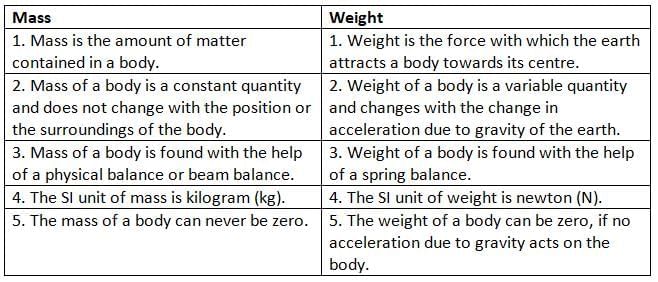
Points To Remember
- The motion in which all the particles of a body move through the same distance in the same interval of time is called translatory motion.
- When a body moves along a straight line, the motion described by the body is rectilinear motion.
- When a body moves along a curved line, the motion described by the body is curvilinear motion.
- The motion in which a body moves about a fixed axis without changing its position is called rotatory motion or circulatory motion.
- The motion of an object, which moves as a whole, to and fro or back and forth along the same path, when an object possesses two or more types of motions at the same time, then that motion is called oscillatory motion.
- A kind of oscillatory motion in which a moving object undergoes a change in shape is called vibratory motion.
- A repetitive motion, which repeats itself after a fixed interval of time, is called periodic motion.
- A motion that occurs again and again, but not at regular intervals of time, is called non-periodic motion.
- When a body covers equal distances in equal intervals of time in the same straight line, the body is said to be describing uniform motion.
- When a body covers unequal distances in equal intervals of time in the same straight line, the body is said to be describing non-uniform motion.
- An object which suddenly changes its motion from one kind to another kind is said to have a random motion.
- The speed can be found by dividing the distance covered by the time in which the distance is covered.
- The speed of non-uniform speed, average speed is calculated by dividing the total distance covered by the total time taken to cover the distance. Its SI unit is m/s.
- The mass of a body does not change with the surrounding or position of body. Mass is found by a physical balance and it is never zero for any material body.
- Weight is a variable quantity and changes with the change in acceleration due to gravity. Weight is found by a spring balance and can be zero, if no acceleration due to gravity acts.
Glossary
- Rest: When a body does not change its position with respect to time or its surroundings.
- Motion: When a body changes its position with time or its surroundings.
- Speed: The rate of change of motion.
- Average speed: It is calculated by dividing the total distance covered by the total time taken to cover the distance.
- Mass: The amount of matter contained in a body.
- Weight: It is the force with which the earth pulls a body towards its centre.
- Physical balance: A device used to find the mass of a body.
- Spring balance: A device used to find the weight of a body.
|
23 docs|3 tests
|
FAQs on Motion Chapter Notes - Basic Technology for JSS 3
| 1. What is the difference between rest and motion? |  |
| 2. What are the different types of motion described in the article? |  |
| 3. Can you explain translatory motion with an example? |  |
| 4. What is circular or rotatory motion? |  |
| 5. What is the difference between oscillatory motion and vibratory motion? |  |















